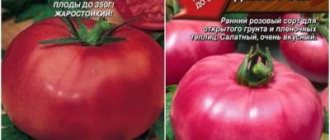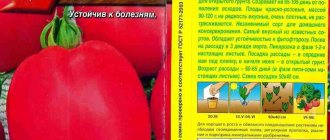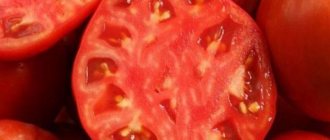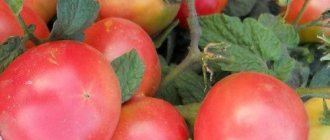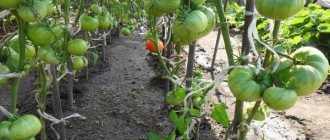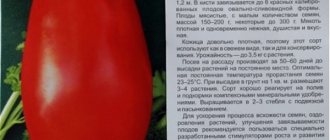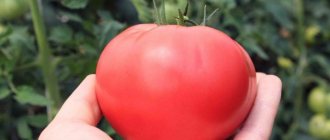Tomato Russian Troika
Early ripening variety
- Fact:
Designed for growing in any type of soil. But it has been noticed that greenhouse tomatoes yield less. - Fact 2:
Tomatoes tolerate long-distance transportation well. They do not deteriorate or crack. - Fact 3:
During the period of active growth and fruit formation, 3–4 fertilizing with complex fertilizers will be required. - Fact 4:
You can avoid insect attacks and diseases by planting fragrant herbs - parsley, celery and others - next to the tomatoes.
This is also interesting!
“Russian Troika” (“Troika”) is a variety with early ripening. Even a novice gardener can grow it. The plant is unpretentious in care, takes up little space in the summer cottage and pleases with a bountiful harvest.
a brief description of
- Where to grow: protected and unprotected soil
- Bush height, cm: 50–60
- Ripening time, days: 102–105
- Productivity, kg: up to 4.7 per bush
- Fruit weight, g: 180–220
- Application: universal
- Advantages: compactness, productivity, disease resistance, transportability, minimal maintenance.
- Disadvantages: none identified.
Advantages and disadvantages
The tomato develops well and bears fruit in areas of risky farming and on the northern border of crop cultivation. The advantages of the Siberian Troika include:
- productivity;
- large fruit;
- high resistance to diseases;
- the variety produces few stepsons;
- There is no need to form a bush in the ground;
- the seedlings do not fall, are strong, low, with a thick stem;
- the fruits are beautiful and tasty;
- tomatoes are suitable for all types of processing and fresh consumption;
- can be planted in greenhouses and open ground.
- fruits of different shapes and sizes;
- requires a garter;
- when overwatered, tomatoes are prone to cracking;
- average resistance to pests;
- extended fruiting - in cool climates, not all tomatoes have time to ripen;
- Although the shoots are thick, they cannot support the weight of the fruit.
Description
"Russian Troika" belongs to the determinant type of plants. This means that the bush stops growing after the formation of 4–6 clusters with fruits. It does not require tying, forming into several stems or pinching. Designed for growing in any type of soil. But it has been noticed that greenhouse tomatoes yield less.
Tomatoes are universal in use . They have:
round, slightly flattened shape;
Tomatoes tolerate long-distance transportation well. They do not deteriorate or crack.
Growing
The recommended method of cultivation is seedlings. Before planting, seeds and soil are disinfected with a solution of potassium permanganate. Seeds can be soaked in a growth stimulator to increase the germination percentage. It is better to bake soil, especially that brought from a summer cottage, in the oven. Sowing time is early or mid-April.
Transplantation to a permanent location is possible at the end of May or beginning of June, after the final retreat of night frosts. Tomatoes are heat- and light-loving plants. Therefore, the earth should warm up to at least 14˚C.
Simple agricultural technology:
watering as the top layer of soil dries;
During the period of active growth and fruit formation, 3–4 fertilizing with complex fertilizers will be required. Liquid mixtures of mullein, bird droppings, phosphorus, potassium, zinc.
Spraying with insecticides will serve as prevention against pest invasion. But they can only be used before the tomatoes begin to ripen. Therefore, many people use folk remedies:
good weeding and digging of the soil, spraying with a decoction of onion peels against spider mites;
soap solution for aphids;
ammonia for slugs;
You can avoid insect attacks and diseases by planting fragrant herbs - parsley, celery and others - next to the tomatoes.
Features of planting and growing the Siberian Troika tomato
A special feature of the agricultural technology of the Siberian Troika tomato is that it is not at all difficult to grow. True, seedless cultivation is rarely used, since it is far from the earliest ripening. In order to have time to harvest the entire harvest in cold regions, this variety is sown as seedlings earlier than others, and they are kept at home for more than two months. Fortunately, the seedlings of this tomato never stretch out or overgrow, but remain stocky, with a thick short stem. To do this, of course, you must not miss the emergence of seedlings and immediately take the seedlings to a cool, well-lit place for a week. Siberian Troika seedlings are planted with 8–9 true leaves, and often with the first flower buds.
Tomato seedlings Siberian Troika are not prone to overgrowth
The seedling planting pattern is 40 x 50 cm or less, sometimes two plants are planted in a hole. Regimes of watering and fertilizing are usual: you should not think that if a variety is highly heat-resistant, then it can do without watering. Until the fruits begin to ripen, the soil should be constantly slightly moist, and even after that watering does not stop at all: in completely dry soil, the fruits of the Siberian Troika can be affected by blossom end rot. Tomatoes are fed 3-4 times per season: first with full fertilizer, and in the second half of summer nitrogen is excluded.
From the point of view of bush formation, everything is simple with this variety: it is almost never done. Only the stepsons that appear below the first fruit cluster are removed, and a few are formed above them, and fruits can form on them. Pinch off the tops of all shoots at the end of summer, a month before the onset of cold weather, to allow the set fruits to ripen and prevent the formation of new ones. In order to increase productivity, many gardeners pick the fruits brown: they “reach” the house well and do not interfere with the redness of the rest.
You don’t have to tie up the bushes if you cover the bed with a thick layer of clean straw. Otherwise, it is better to drive in pegs and tie up the stems as the fruits become heavier. If you do neither, tomatoes lying on the ground may rot.
Video: Siberian Troika tomato harvest
Appearance and description of the variety
It is enough to study the forums of gardeners and gardeners to come to the conclusion that everyone likes the Troika tomato. This is not surprising, given the characteristics and description of the variety: juicy heavy fruits, rich harvest, unpretentiousness and disease resistance. The tomato bush grows up to 60 cm and is classified as standard. Simply put, it is a bush on a leg. This form of the plant allows it to take up less space, which is especially important on the notorious “six hundred square meters”.
Fruit characteristics
Tomatoes have a pronounced sweetish taste, ideal for salads and snacks. The shape of the fruit is elongated and reaches 15 cm. Sometimes its appearance vaguely resembles a red capsicum. The flesh is dense , or, as tomato fans affectionately say, “meaty.” The weight of one tomato reaches 300 g.
Advantages and disadvantages of the variety
The undoubted advantages of the vegetable include its unpretentiousness. Even a novice gardener can cope with plant care. The Siberian Troika tomato, as already mentioned in the description of the variety, grows compactly and saves you useful space. If this factor is not so important, then there is another advantage - standard bushes look very beautiful and will decorate your site.
Description and characteristics of the variety
Siberian Troika tomatoes grow in open ground like semi-standard ones. They reach 60 cm and do not need to be formed, especially since they form few stepsons. But the bush seems to be spreading because of the wide-spread long leaves.
Have you already grown the Siberian Troika tomato?
Yes
39.67%
No
60.33%
In greenhouses, tomatoes grow in 2-3 stems, the shoots stretch up to 120 cm. They are thick, strong, but without a garter, under the weight of the fruit they can break or lie on the ground.
The Siberian Troika tomato variety differs from others even at the seedling stage. It is not inclined to stretch, compact, strong, with a thick stem.
The leaves are very large, with narrow segments, widely spaced. If they are not standardized, the bush becomes very thick. They seem clumsy, but this is not a disease or imbalance of nutrients, but a varietal feature.
The first fruit cluster is formed after 6-7 leaves. Subsequent ones - after 2-3 internodes. In total, 5-6 brushes grow on the main shoot. The rest of the harvest is taken from the stepchildren.
This tomato should not be confused with the Troika variety (Russian Troika). They are similar – only the name, even the shape of the fruit is different. Often the negative reviews received by the variety actually refer to the Troika created by the agricultural company Aelita.
Description of fruits
The Siberian Troika tomato, the variety description of which calls for the formation of pepper-shaped fruits, actually produces tomatoes of different sizes. They can be elongated, as in the photo. But often on one bush fruits grow that look like peppers, pears or barrels. Each brush, without standardization, contains from 5 to 10 ovaries.
The taste of the fruit is very good, the color is classic red. Like shape, size can vary greatly. The mass of the lower ones reaches 350 g, length - about 15 cm.
On the upper clusters, the tomatoes gradually become smaller, but they only become too small if there is a complete lack of care and unfavorable weather conditions.
The pulp is dense, but juicy, with a high sugar content, pinkish when cut. There are few seeds.
The first brushes ripen quite quickly, in the mid-early period. But the pouring of the upper fruits is extended. This is not very good for the Siberian regions. When grown in soil, not all tomatoes have time to ripen. But the brown ones can be ripened indoors, and the green ones can be used in winter salads.
The Siberian Troika tomato is suitable for all types of processing. The first tomatoes are not used for whole-fruit canning - they are too large. But the ovaries from the upper clusters, after ripening, fit perfectly into the jar.
The harvest from one bush is 5 kg. For short tomatoes, especially Siberian ones, this is an excellent result.
Agricultural technology
The task of every gardener is to grow a good harvest with minimal labor and resources. But even such an unpretentious variety of tomatoes as “Siberian Troika” requires certain knowledge and proper planting and care techniques. Agricultural techniques include all necessary actions, from preparing planting material to harvesting.
Preparing seeds, planting seeds and caring for them
The very first step in preparing seeds is their culling. That is, the selection of the most promising samples. For this, 1 tsp. salts are diluted in a glass of water, seeds are placed in this solution and stirred for several minutes. Then you need to wait 10 minutes and observe the result. Empty seeds will float, while large, full-bodied seeds will settle to the bottom. They need to be washed and dried, this is the basis of the future harvest.
If tomato seeds were stored in the cold, they should be warmed up a month and a half before planting. The procedure itself will take about a week, since warming up is recommended to be done gradually, increasing the temperature from +18 °C to +80 °C. The seeds are placed in fabric bags and heated on a radiator for several days.
Towards mid-April, the soil is prepared. It will be better to heat it a little in the oven, especially if it is soil from your dacha and not specially purchased.
It is advisable to germinate the seeds before sowing. To do this, moisten a paper napkin with water and place it on a dish. Then the tomato seeds are placed on a napkin, covering them with the free end, and the plate with all the contents is placed in a bag. In a warm place, sprouts will appear in three days; the main thing is not to forget to moisten the napkin as it dries.
Tomato seeds are planted in containers, preferably special plastic boxes with a tray. They are easy to disinfect and move if necessary. Each container must have holes to allow excess moisture to escape. Before planting, both the soil and seeds are treated with a solution of 1% potassium permanganate to avoid the appearance of unwanted microorganisms.
After the soil and seeds are prepared, we begin planting. Firstly, a layer of drainage is placed on the bottom of the boxes - small pebbles or crumbled egg shells. Secondly, you need to fill the soil and immediately water it with warm water. Then our germinated seeds are placed to a depth of no more than 2 cm. If you are still inexperienced in gardening, first make a hole in the ground to the required depth, and then feel free to lower the seed into it. Now all that remains is to cover the containers with film and place them in a warm place.
If everything is done correctly, you will see the first shoots within a week. And this event will mean that it’s time for our seedlings to go into the sun: the containers are transferred to the windowsill.
After the seedlings get a little stronger, they are picked. Using a picket stick 10 cm long, the sprouts are dug up and pryed up, pulling them out of the container along with the earthen lump. Sick and underdeveloped specimens are removed; in healthy ones, the root is pinched by about a third with a fingernail.
Now the sprouts will live in separate, more spacious pots. For them, in a new place in the soil, a hole is made with the same picket, spacious enough so as not to damage the root during planting. After completing the procedure, lightly press the soil onto the roots with your finger and water generously. If the soil has subsided, it needs to be replenished. The last stage is moving the seedlings to a semi-dark place.
Seedlings and planting in the ground
Seedlings can be transferred to the beds at the end of May. If the spring cold lasts longer, the planting date is postponed to the beginning of June. Strong sprouts, ready for planting, have at least nine leaves, and their height is not lower than 24 cm.
When preparing the site, it is worth considering that tomatoes love warmth and sunlight, so it is better to plant them in an open place. If possible, then under the white wall of the house there will be an ideal place - the light reflected from the wall will again fall on the vegetables.
Seedlings are planted in open ground after lunch. In the first half of the day, the seedlings are prepared: watered abundantly to make it easier to remove the sprouts. Holes the size of the pot are dug in the soil, and humus or mineral fertilizer is placed in them. After carefully planting the seedlings, water it, and then sprinkle the holes on top with dry soil.
Tomatoes are most often planted in a checkerboard pattern. There should be a distance of at least 70 cm between the rows, and about 50 cm between the bushes.
Northern blush: description of the tomato variety, characteristics of tomatoes, sowing – Russian Dacha
It's hard to imagine a garden without beds of tomatoes. This vegetable crop has been cultivated for many centuries. During this time, hundreds of species and subspecies of tomatoes were developed. And in order for the harvest to please you, you need to carefully study the information about the chosen variety.
Description of the variety and characteristics of the fruit
The “Northern Blush” tomato is an early, determinate variety that is resistant to cold and is very popular for this reason in the northern regions. The variety is intended for cultivation in open soil.
The main distinctive feature of this variety is that, unlike many other varieties, “Northern Rumyants” does not require pinching. But it is advisable to tie the bushes to the support.
The tomato has medium-sized leaves of light green color with a simple inflorescence.
The fruits of the Northern Blush tomato have a round shape. The fruit density is average. The ripe fruit is red. The average fruit weight is 90-130 grams. Some summer residents note fruits weighing about 110-120 g. For an early variety of tomatoes, it has good taste. The variety is used for salads, and tomato products and pickles are made from the fruits.
Late blight
The insidious disease Late blight is a huge headache for all summer residents. Because of it, several thousand kilograms of crops are lost every year. But the “Northern Blush” tomato will have time to ripen before late blight sets in; this is directly related to its early ripening.
Important fact! Due to the fact that late blight is found on the hairs of tomatoes, it is reported that the causative agent of this disease can be easily transmitted by seeds, and this causes the infection to become cyclical.
Productivity of the variety
One square meter of soil yields approximately 6 to 8 kilograms of yield. This tomato feels better if grown in film greenhouses without heating. 55-60 days before the intended planting, you can already sow seeds into the soil for seedlings.
History of the variety's creation
This tomato was bred by breeders specifically for harsh climates. In regions with harsh climates, summers are cool and quite short.
“Northern Blush” really likes these conditions and the harvest is excellent. In our country, this variety grows well in the Moscow region, in some regions of Siberia, in the Far East and in the Moscow region.
The plant can be grown not under film cover.
Important! Do not heat greenhouses under film covering conditions!
Advantages of the variety
- tolerates low temperatures well;
- tomato does not require pinching;
- no pinching of tops required;
- grows well both in beds and under film cover;
- the fruits ripen at the same time;
- Tomato is resistant to a wide range of common diseases.
The variety has no disadvantages
Plant care
The tomato variety “Northern Blush” is a determinate variety.
On a note
Ripe fruits handle transportation very well. But very long distances are less tolerated. This variety has an excellent taste and they have also proven themselves well when used fresh, in pickles and when making juices.
You may be interested in:
There are few leaves on the “Northern Blush” tomato bushes; the plant is a weakly leafy plant.
In order for all the fruits to ripen during the season, bushes of this variety must be formed into one, two or three stems, but no more.
Northern blush actively resists all kinds of diseases. It is for this reason that the variety is recommended for cultivation by beginners.
Advice!
If you don't have a garden and are planning to grow tomatoes at home, plant the seedlings two months before planting them in open soil.
Do I need to tie it up?
All tomatoes inevitably undergo a simple procedure called tying. And varieties with high yields and tall varieties, that is, high-yielding varieties of tomatoes, need to be tied up.
Pros of a garter
- Tall plants, which include tomatoes, break and fall under their own weight.
- On tied plants, the fruits do not lie on the ground. This helps protect them from various diseases and various pests.
- Weeding and pinching tied tomatoes is much easier.
- Plants that have undergone the tying procedure are easy to water at the very root, and it is also easy to apply fertilizer.
How to tie up tomatoes in a greenhouse
It will be much easier to do this in a greenhouse, but you can try to tie up tomatoes in open soil.
For both options you will need:
- rope or nylon tights;
- two supports to which we will tie.
Do not use fishing line, wire, thin twine or other similar materials for garter, which can cut into the stem and damage it.
Tying options
- Method of fastening to a wire frame. This method is good for varieties that produce large yields.
- Linear fastening method. A very convenient method for fastening bushes in long greenhouses. The design includes two metal pipes at different ends of the shelter. The method is not suitable for tall bushes that produce a large harvest.
- Method of tying using a trellis. For tall varieties, a male support is used at different ends of the greenhouse. Ropes are pulled between the supports. Interval 30 centimeters.
- Vertical trellis method. This is a variation of the previous method. Ideal for gartering tall tomatoes whose side shoots have been removed. The tomato “crawls” along a rope that needs to be suspended from the ceiling of the greenhouse. Ideal for tall plants.
- Mesh attachment method. This option is called combined because it combines trellis fastening with fixation using mesh.
Tomato Northern blush
Rating of those who grew:
Source: https://viridarus.ru/uhod/severnyj-rumyanets-opisanie-sorta-tomata-harakteristiki-pomidorov-posev.html
Conditions for maximum fruiting
To ensure that as many Siberian Troika tomato seeds sprout as possible, you can soak them in a growth stimulator before planting. Modern agronomy looks positively at biostimulants, arguing that they not only accelerate growth, but also increase crop resistance to fungal diseases. Whether you use them or not is up to you.
The process of soaking seeds is carried out only after they have been disinfected with a solution of potassium permanganate or one of the modern bacterial preparations. The average procedure time is from 18 to 24 hours. Do not forget to carefully study the instructions for the selected preparation, otherwise you risk burning the seeds.
“Troika” is a mid-season tomato, as the description in the register says. And by stimulating the growth of the crops, you also achieve rapid ripening of the fruits.
Which tomato seeds are the best - the right choice and hardening +
Despite the popular belief that it is better to plant tomatoes in greenhouses, there are several species that live and develop well in the open. soil, for example, the best seeds for open-planted tomatoes are the varieties Penguin, Cipollino, Amursky Shtamb and Betalux.
The first theme is that even a small bush will be strewn with dozens of fairly large tomatoes - from one bush you can harvest up to ten kilograms of harvest even in the spring.
The other three are characterized by small growth, but they guarantee a large harvest in any region.
The varieties Kukla and also Azhur used for open planting are very good for planting. Much depends not only on the variety, but also on the time of planting .
early, For example, types are best planted in early March, since this time allows you to achieve a rich harvest already early Naturally.
The term is that planting is first done in boxes or cut plastic bottles, which are stored either in the room or placed on the balcony, and after the seedlings have only appeared, the tomatoes can be grown.
replant good tomato seeds, varieties of which are suitable for planting in open ground, “are northern”. These include: Uvalen, Siberian, Flash Trump, Nimble, Rumyants of Petersburg, If.
Buyan you will be able to grow in a greenhouse, of course, you are luckier. First of all, because the list of varieties suitable for planting is wider. And secondly, it is much easier, because the care inside the greenhouse, the conditions for keeping other vegetables and fruit crops, are much better. Varieties Suitable:
- Paradise - large-fruited tomatoes that no longer reach 1.2 m in height (on each cluster there can be 200 to 300 grams).
- Native is an early variety suitable for the northwestern regions.
- Igranda is quite famous, characterized by its round and large fruits, the fruits of which can reach 150 grams. resistance Characterized by sudden changes in temperature and humidity.
- An early well-known variety is the Pavlovsk rose: it is purchased for further preservation.
- The Resource variety is also pleasing, the fruits of which reach 150 grams, and the tomato itself bears fruit for a very long time.
- The small Russian tomato troika, whose bush height is not 60 cm, reaches fruits weighing up to 200 grams.
Of the well-known ones, we can name Skorokhod, Izyum, in principle. In Perchik, you learned about the best tomato seeds for both open ground and greenhouse planting. But we must remember that a lot depends on how you prepare them for subsequent professional training.
When planting, gardeners can easily confirm that self-grown seedlings will be much more fertile when purchased than in a store. And all because it takes a lot of effort and time to grow, and the plants being sold for planting are not distinguished by either fertility or health.
Of course, preparing seeds yourself, hardening them and planting them will require time and care from you, but this cannot be done without if you want a good harvest. There are several rules that will help you grow good tomato plants. the bushes concern tomato seeds, which must be processed and “hardened” before planting:
- that, The first thing you need to do is soak them in a solution For. To obtain potassium permanganate, we buy a packet of potassium permanganate in the pharmacy and dilute it in the following proportion: for one glass of powder 1 g of water. You can wrap the seeds in a bag and lower it into a solution of potassium permanganate for 20 minutes. After this, be sure to rinse them with water. This operation will allow you to get rid of possible viral diseases;
- potassium permanganate After soaking the seeds in a special nutritious solution. To prepare it, take one spoon of tree bark, Ideal liquid fertilizer and 25% teaspoon of sodium humate powder, dissolve them in a liter of water. Next, we lower the bag of seeds into this solution again, but this time for at least 12 Main. hours so that nutrient solutions, potassium permanganate and water are at least 24 °C.
Such work will allow your garden to be rid of diseases, and pests will also not annoy grapes, fruit trees and vegetables.
crops with which tomato seeds are the best, you need to take care of caring for them. There are several important recommendations that will help you grow healthy and fruit-bearing bushes.
For example, before planting tomatoes in the ground, they should be about two months old. Also keep track of how strong and strong the shoots are.
Seedlings are considered strong if each plant has approximately 10-12 leaves.
An important point to consider is that watering is carried out once a week at the beginning of growth.
The optimal amount of water per bush is one – half a glass. When the plant has three leaves, you can use one glass of water. Twice a week you need to feed the tomatoes. The first time it is carried out two weeks after germination.
It needs to be done on the basis of a nitrophoska solution: for one bucket of water (10 liters) take a spoonful of fertilizer. The next time the plants are fed ten years later. At this stage, it is best to use a fertilizer such as Effecton: take a tablespoon of the drug per ten liters of water.
Two to three days before planting, a final fertilizing with this same solution is carried out.
Also remember that any fertilizing is carried out only when the soil is damp, then after watering. If you strictly adhere to all the above rules and select a suitable plant variety, take care of the seeds, then in the end you will get a high-quality harvest, and juicy and large tomatoes will decorate your table!
Source: https://agro.jofo.me/574626.html?relent=28
Use of fruits
“Troika” has a delicate and at the same time bright taste. So add it to a salad, appetizer or other dish of your choice and truly enjoy the fruits of your labor. You can eat a tomato without anything. The fact that it was you who grew such a masterpiece with your own hands will give any dish a unique taste.
Any heat treatment is possible with this variety of tomatoes. The dense structure makes it possible to perfectly preserve fruits; they turn out strong and juicy. They also preserve tomato juices, all kinds of borscht dressings with the addition of tomatoes, and even jam.
The Siberian Troika tomato variety is an ideal option for those who love tomatoes, but are not ready to fully immerse themselves in the world of gardening. They don’t need to be tied up, they don’t get sick, they bear fruit well and even decorate their summer cottage. But they need minimal care, which should not be neglected.
Description of the tomato variety “Russian Troika”
The “Russian Troika” matures in a relatively short time. From the emergence of seedlings to the full ripening of the fruit, about 102-105 days pass. Plants do not grow higher than 50-60 cm. The bush has a powerful, highly leafy stem. A characteristic feature of the exterior of this variety is dark green potato-type leaves with an anthocyanin tint.
Fruit
Tomatoes have a classic flat-round shape with slightly pronounced ribbing. Ripe fruits weigh about 180-220 grams. The skin color is bright red.
Growing tomatoes
“Troika” is grown traditionally - through seedlings with subsequent planting in a permanent place. It is advisable to cultivate this variety in open ground, since the yield in a greenhouse can be significantly lower. Tomato is not picky about soil, and its seeds produce good seedlings in the second and subsequent generations.
How to prepare seeds?
On the eve of planting, pre-sowing seed treatment is carried out. This is done to accelerate growth, strengthen immunity and increase germination from the nominal 60 to the desired 90%. Processing includes the following procedures :
- Inspection of seeds to identify those that are not suitable for planting: those that have a loose structure, are empty, have signs of damage, or are not uniformly colored;
- Disinfection in a solution of potassium permanganate or hydrogen peroxide for 20-30 minutes;
- Soaking in purified water for 12 hours so that the seeds can absorb moisture and open. Ideally, secondary defrost melt water should be used. The resulting liquid is poured into the seeds, and an aquarium pump is installed in the same container, saturating the water with oxygen. This treatment is called bubbling. With its help, you can reduce the total ripening time of plants to 5 days.
Early ripening varieties of tomatoes:
Sowing seed material
Sowing of seeds is carried out in the first half of April - 2 months before planting for permanent residence. It is not recommended to sow earlier due to low solar activity: seedlings sown in April, within 45 days, catch up in development with seedlings sown at the end of March.
Store-bought soil is used as a substrate for growing vegetable seedlings. You can prepare the soil yourself. To do this, you need to mix garden turf, peat and sand in a ratio of 2:2:1, add about 10% vermicompost and a small amount of perlite and vermiculite.
A 2-cm layer of drainage (kermazite or charcoal) is poured onto the bottom of the planting container, then the main soil. The seeds are placed in grooves 1.5 cm deep, sprinkled with peat, and watered with warm water. Before sprouts peck, the seedlings are covered with glass or film. After germination, the seedlings are exposed to light. Once every two weeks, seedlings need to be fed with mineral complexes, periodically watered and loosened the soil.
Rules for planting seedlings
Plants are planted in open ground in the second half of May. This period is considered the most favorable, since the night temperature does not fall below 15*C, and spring moisture still remains in the ground. By this time, the tomato bushes have stretched up to 25-30 cm, and at least 6 true leaves are formed on each of them.
Before planting, seedlings undergo hardening training for 2 weeks. Plants are placed in a cool room with a temperature of 16-18 * C and watering is gradually reduced. 5 days before planting, watering is stopped completely.
The bushes are transplanted into specially prepared holes, spilled with warm potassium permanganate and fertilized with humus (200 grams for each plant). When replanting, it is important not to damage the root system, so the plant is removed from the pot with a large lump of earth. It’s even better if the bush can be planted in the garden without removing it from the container. To do this, at the picking stage you should use peat pots or paper cups.
Recommended planting pattern:
- The interval between bushes is 30 cm;
- Row spacing – 60 cm;
- The depth of the planting hole is 15 cm;
- The distance from the first sheet to ground level is 4-5 cm;
- The maximum plant density is 8 plants per 1 sq.m.
Tomato sprinter f1 description – Summer resident’s guide
Tomatoes are the most favorite crop that gardeners grow in almost every garden plot.
With the onset of spring, vegetable growers have to make a choice; they usually plant proven varieties and a few new ones. When choosing a variety, it is important to take into account natural conditions, growing characteristics, shape and size of tomatoes. Seeds of Siberian selection are especially popular. Today we will present an overview of new tomato varieties for 2021.
In previous years, the following varieties from the Siberian selection “Beef”, “Pink Honey”, “Scarlet Candles”, “Abakan Pink” and many others were very popular among summer residents.
Breeders from Siberia managed to create plants that bear fruit well in extreme conditions. New tomato varieties for 2021 from Siberian selection have a lot of positive qualities.
This season they will certainly delight gardeners with rich harvests.
The main advantages of Siberian selection
Varieties of Siberian selection can be selected to suit every taste; they are divided into groups depending on the type of plant, fruit size, purpose and growing environment. Today Siberian selection includes:
- "Seeds of Altai".
- "Siberiada".
- "Siberian Garden".
The Siberian selection surprises with the size of the bushes; large tomatoes ripen on short plants, but there are also truly gigantic bushes with a large number of fruits. Here are the most popular qualities created by breeders:
- plants grow excellently in short daylight conditions;
- undemanding to natural conditions;
- do not require complex care;
- many large-fruited varieties;
- increased productivity;
- are among the first to ripen;
- good immunity to many pathogenic microorganisms.
Review of new tomato products
"Bulls-eye". Early Cherry requires 95 days to fully ripen. The bush looks very decorative and serves as a real decoration for the site. Tomatoes are round, red in color.
The height of the plants is about 2 meters, with simple clusters in which 30-40 small tomatoes ripen. Tomatoes ripen at the same time and are characterized by a high leucopene content.
Tomatoes are used in culinary dishes, fresh, pickled, and marinated.
"Havana cigar" Medium early species, ripening occurs within 115 days. Tomatoes are elongated, vine-shaped. Plants are intended for growing in protective soil.
The height of the bushes is up to two meters, the cluster is simple with 5-7 red fruits. Tomatoes of this variety are well suited for canning; thanks to their thick skin, the fruits can easily withstand transportation over long distances.
The variety is marked as productive per 1 m2. 12 kg of vegetables are collected.
Advice! Determinate types of tomatoes should be planted in beds or greenhouses, as they form low bushes. Indeterminate varieties are grown in polycarbonate or glass shelters.
The height of this type of plant is from 150 to 200 cm, and up to 12 kg of tomatoes are obtained from one bush.
"Casanova". A mid-season variety, its peculiarity lies in the original shape of the fruit, as well as increased productivity.
The bush grows up to 2 meters, 5 fruits of a red hue ripen on the clusters, oblong in shape up to 20 cm. The most common tomatoes are those that weigh from 150 to 200 grams. The taste of tomatoes is good and pronounced. Preventive protection against late blight is necessary.
Tomatoes are stored for a long time and do not crack when preserved. Tomato Casanova is recommended for planting in closed buildings.
"Strawberry Tree" A mid-season variety, the tomato takes 112-115 days from germination to ripening. This tall plant reaches a height of two meters, the stem is powerful, with a large number of leaves.
Six clusters are formed on one bush; most often 5-7 tomatoes ripen in them. Tomatoes are red in color and their shape resembles a strawberry. The bush of this variety has a spectacular appearance, reminiscent of a small powerful tree. The fruits are dense, from 200 to 250 g.
, pleasant dessert taste. Productivity is increased, up to 12 kg can be harvested from 1 m².
"Queen Victoria F1". This early ripening hybrid matures in 95 days. The plant is of a determinate type, stocky, bush height is 100 cm. The variety is famous for the early and simultaneous ripening of all fruits. The shape and size of tomatoes attract buyers at the vegetable market.
The tomatoes themselves are dense, fleshy, red in color, smooth, round with a protruding “spout”. The average weight of tomatoes is 190-300 grams, with good taste. This variety is resistant to cracking, is not damaged during transportation, and is used both in winter preparations and in the preparation of many dishes.
The plant does not get sick and feels good in open beds and greenhouses. This hybrid gives a high yield of up to 17 kg of fruit per 1 m².
"Siberian Sprinter". A mid-early variety, 100-105 days pass from germination to fruiting. The fruits ripen at the same time, in whole clusters of which there are up to 12 bright red tomatoes.
The height of the bush is 1-1.2 m, it needs support and fixation. Tomatoes are quite tasty; they make excellent dishes and pickles. The Siberian sprinter grows well in ordinary beds, greenhouses and greenhouses.
With good care, up to five kilograms of fruit can be harvested from one plant.
Attention! Those who love large sizes should pay attention to such varieties of tomatoes as: “Lemon Giant”, “King of Kings”, “Pink Honey”, “Russian Soul”, “Fidelio”.
"Cherry Banana". Cherry variety, ripens early, tomatoes have an original elongated shape, orange color and fruity taste.
The weight of tiny tomatoes is 20-30 grams. This variety is successfully used in children's diets; when pickled, the fruits do not crack and can serve as a decoration for dishes. The plant is formed into two stems and secured to a support. Cherry Banana tomatoes are grown in closed structures.
Up to three kilograms of tasty fruits are collected from each plant.
"Zimarevo Giant" The variety produces high yields, the fruits are formed stably, and grows well in closed structures. Raspberry-colored tomatoes have a round, flat shape. The weight of individual copies is up to 600 g.
The bush itself is tall, up to two meters high, up to five clusters are formed on it, which contain 5-6 large tomatoes. For stable pollination, plants are shaken several times a week.
10-15 kg of vegetables are harvested from 1 m².
"Cherry Olive" The variety is an early variety; harvest can be harvested at 90-95 days. This determinate species produces small red tomatoes, weighing up to 20 grams. which are similar to Greek olives.
The bush is squat, 50-60 cm high, grows well in greenhouses and open areas. The fruits of this variety contain a lot of dry matter, so it is ideal for drying, drying, salting and pickling.
The plant tolerates temporary cold spells, prolonged rains, and heat well. From 1 m² you can harvest 3 kg of small aromatic tomatoes.
"Freken Bock." A new variety developed by Siberian breeders. Plants are planted in open areas and greenhouses. Freken Bock tomatoes ripen earlier than other large-fruited tomatoes. The plant tolerates dry periods without damage, develops well and produces crops in the Siberian regions.
The bush is strong, sparsely leafed, up to 1.6 meters high. When tomatoes ripen, they acquire a crimson color, the skin is smooth, and the fruit weighs up to 500 grams. The taste is dessert, the tomato is good for eating fresh, juices, sauces, and purees are prepared from it. The yield is up to 10 kg per 1 m², which is generally very good.
You may be interested in:
"Turbojet". A very early tomato, does not require special care, grows well in open beds. There is no need to tie up the bushes or remove the stepsons. Even in cool and rainy summers, this variety bears fruit consistently.
https://www.youtube.com/watch?v=S1NJl_XMTMg
Ripe tomatoes of a red hue, flat-round shape, weighing up to 80 g. At the beginning of July you can try the first ripe fruits. Each plant can produce 2 kg of tomatoes. Seedlings at the age of 70 days can be planted in an open area.
3-5 bushes are planted per 1 m².
“Beefseller pink F1” Early ripening hybrid, indeterminate type. It takes 90-100 days from the appearance of white loops to harvesting the fruit.
The fruits are dark pink, round in shape with a characteristic “spout”, with dense pulp. Weight of ripe tomatoes 250-400 g. The plant is formed into one stem, on which 5 to 7 clusters develop.
About 7 tomatoes ripen in each cyst. Sweet tasting tomatoes.
"Favorite holiday". The variety is mid-season, determinate, and is characterized by stable and high yields even in unfavorable weather. The stem of the plant is powerful, the average height of the bush is 80 cm.
The fruits are heart-shaped, slightly ribbed, deep pink in color, weighing from 900 to 1300 g, with excellent taste. Tomatoes of this variety are used to make salads, juices, and sauces. No more than three plants are planted per 1 m².
"Matryosha" The mid-early variety takes 110-115 days from germination to fruiting. The bush is powerful, up to 1.7 meters high. 4-6 fruits ripen on one plant, up to 15 cm long and weighing up to 300 grams. The tomato pulp is dense, sugary, and has an ideal taste.
Salads are prepared from the fruits of this variety; Matryosha tomatoes are also good for canning. The abundant yield of the variety allows you to get 10 kilograms of fruit from one square meter. The manufacturer recommends planting four plants per 1 m².
"Marshal victory." One of the new varieties of Siberian selection. It is characterized by high productivity; over the years of testing it has repeatedly shown excellent results in yield and maximum weight.
Tomatoes are grown in greenhouses, greenhouses, and open beds. Marshall Pobeda is an indeterminate variety with an average ripening period (110-115 days).
Strong bushes grow up to 2 meters, when planted in open areas they reach 1.2 m.
When tomatoes ripen, they acquire a red tint, a rounded-flat shape, medium-sized tomatoes weigh 300-400 grams, individual specimens can weigh up to 1 kg. The variety is distinguished by the excellent taste of the fruits, from which salads, juices, pastes, and sauces are prepared. More than 12 kg of fruits are collected from 1 m². If necessary, remove the tomatoes for ripening.
Good to know! In areas of risky farming, it is optimal to plant early ripening varieties.
"Lazy girl." An early ripening variety of tomatoes from Siberian breeders. The plant is not tall and requires pinching only up to the first cluster. The fruits actively grow on the lateral stepsons.
Source: https://agro-akcent.com/tomat-sprinter-f1-opisanie/
Bush care
Determinate plants do not require pinching or staking the stem. However, during the fruiting period, supports should be placed under the heaviest fruiting branches to avoid them breaking off.
Otherwise, caring for the “Russian Troika” is no different from caring for other tomatoes.
It is necessary to carry out such activities:
- Shallow watering every 3-5 days. It is welcome to install a drip irrigation system, which will evenly distribute moisture in the garden bed and save water consumption by 30%;
- Loosening the soil after each watering to prevent the soil from sticking together and forming an earthen crust;
- Weeding , especially during the first 14 days after planting seedlings, while rooting is underway;
- Fertilize with NPK fertilizers once every 2 weeks.

